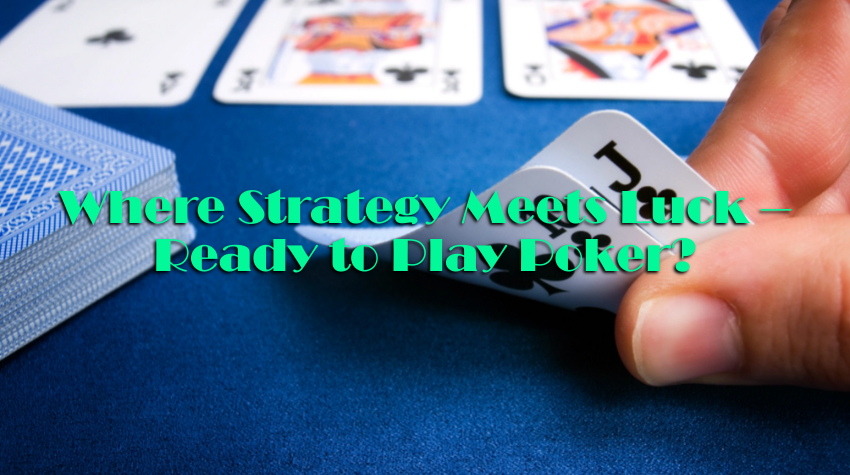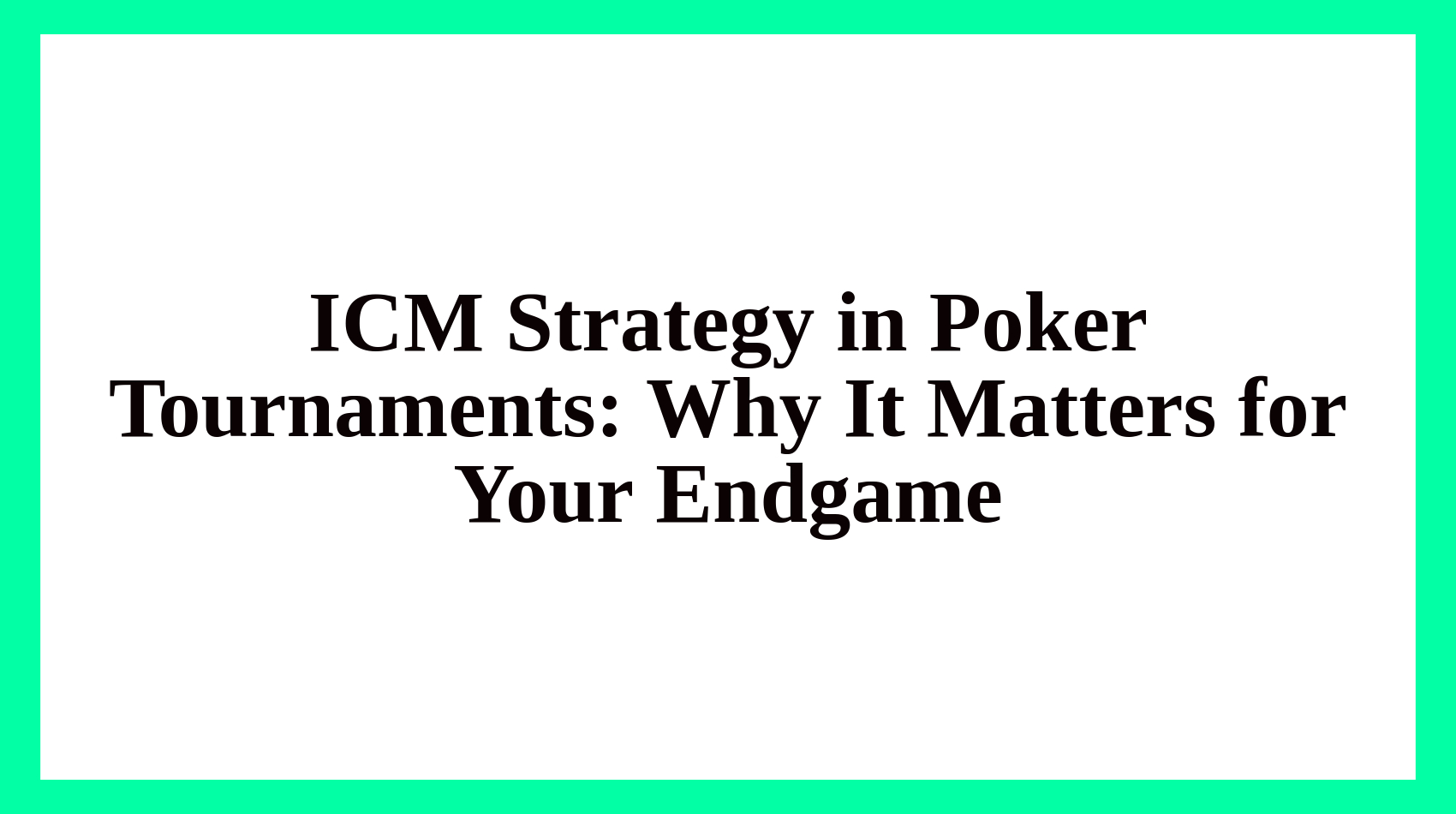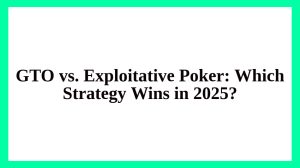Introduction: Understanding the Value of Your Chips in Tournaments
In poker, skill, luck, and timing all work together—but in tournaments, there’s one concept that separates experienced players from beginners: the ICM Strategy, short for Independent Chip Model.
Unlike in cash games, where every chip equals real money, tournament chips don’t have a direct cash value. Their value changes constantly based on your stack size, blinds, and how close you are to the payout ladder. That’s where ICM becomes crucial—it helps you decide when to risk your stack and when to protect it.
Whether you’re a casual player in Japan joining small online tournaments or a serious competitor in global events, learning ICM Strategy will help you survive longer, make better endgame decisions, and maximize your payouts.
If you’re new to poker, it’s best to first understand the game’s basics here:
👉 What Is Poker?
What Is ICM in Poker Tournaments?
Definition and Purpose
The Independent Chip Model (ICM) is a mathematical system used to estimate the monetary value of your chip stack during a tournament. It translates chip counts into real-world equity—your expected share of the prize pool if the tournament ended at that exact moment.
Simply put, ICM tells you how much your current chips are worth in money, considering all remaining players, their stack sizes, and the payout structure.
Why It Exists
In tournaments, chips are unevenly distributed, and only a few players win cash prizes. Because of this, one chip lost can be more expensive than one chip gained.
For example:
- Losing half your stack can significantly reduce your potential payout.
- Gaining the same number of chips doesn’t increase your payout as much.
ICM was designed to solve this imbalance. It ensures players think in terms of money equity rather than chip count, guiding when to fold, call, or shove.
How ICM Works in Simple Terms
1. The Basic Idea
Imagine there are 10 players left in a tournament with the following payouts:
| Position | Payout |
| 1st | $5,000 |
| 2nd | $3,000 |
| 3rd | $2,000 |
| 4th–10th | $0 |
You have 30 % of the chips in play.
You can’t claim 30 % of $10,000, because if you lose all your chips before others bust, you’ll get $0.
ICM calculates your average expected payout based on the probability of finishing in each position.
This helps you see how much each chip is worth and decide whether an aggressive move is worth the potential risk.
2. Chips Don’t Equal Cash
In cash games: 1 chip = 1 unit of currency.
In tournaments: 1 chip = potential value.
For instance, doubling your stack late in a tournament might only increase your payout equity by 10–15 %, not 100 %. That’s why reckless plays near the bubble (the point before payouts begin) can be disastrous.
3. ICM in Action
Suppose three players remain:
- Player A – 50 % of chips
- Player B – 30 % of chips
- Player C – 20 % of chips
Total prize pool: $10,000
Payouts: $5,000 / $3,000 / $2,000
ICM would estimate:
- A’s equity: ≈ $4,100
- B’s equity: ≈ $3,200
- C’s equity: ≈ $2,700
Notice that C has only 20 % of chips but 27 % of equity—because smaller stacks have higher survival value. Losing means $0, so conserving chips is critical.
Why ICM Matters in Poker Tournaments
1. Protects Your Equity
ICM ensures you don’t gamble unnecessarily when survival is worth more than chip accumulation. Near the bubble, each elimination increases your real-money value, so tight, disciplined play is rewarded.
2. Encourages Smart Risk Management
Aggressive chip accumulation makes sense early on, but ICM teaches restraint when real money is at stake. Players who understand this preserve their stacks and reach deeper runs more consistently.
3. Improves Endgame Performance
At final tables, ICM helps you determine when to call or fold against all-ins based on prize jumps. Even one incorrect call can cost thousands in expected value.
Key ICM Concepts You Need to Know
1. Chip Equity vs. Money Equity
- Chip Equity: The size of your stack relative to total chips.
- Money Equity: Your potential payout value based on chip equity and payouts.
ICM converts chip equity into money equity. This difference is what makes tournament decisions unique.
2. Bubble Factor
The bubble factor is how much more costly it is to lose chips than to win them.
When close to the bubble, the bubble factor can reach 2 or 3, meaning losing one chip hurts twice as much as gaining one helps.
3. Risk Premium
Because of the bubble factor, you need a stronger hand than usual to call an all-in.
For example, a hand like A-Q might be an easy call in a cash game, but in a tournament bubble, folding it might be correct under ICM.
4. Pay Jump Pressure
As you move up in payouts (e.g., from 4th to 3rd place), ICM shows that every position jump increases your monetary value. This affects how wide or tight you should play.
How to Apply ICM Strategy in Different Stages of a Tournament
Early Stage — Chip Building
- ICM impact is minimal.
- Focus on playing profitable hands and building a stack.
- Avoid reckless plays against bigger stacks, but don’t be afraid to gamble with strong hands.
Goal: Accumulate chips for later stages where ICM becomes important.
Middle Stage — Approaching the Bubble
- ICM starts to matter as the payout line approaches.
- Big stacks can pressure short stacks knowing they must fold more.
- Medium stacks should play carefully to avoid busting before the money.
Example:
If 12 players remain and 10 get paid, short stacks will tighten up to guarantee a payout.
ICM says you can exploit this by stealing blinds and small pots aggressively if you have a big stack.
Late Stage — Final Table and Endgame
- ICM influence is at its highest.
- Every decision is worth real money.
- Fold marginal hands when a shorter stack is about to bust.
At this point, even a single fold can increase your expected earnings more than a risky call would.
ICM Decision-Making Examples
Example 1: The Bubble Spot
- 11 players remain, 10 get paid.
- You have a medium stack.
- A short stack goes all-in.
- You hold A♠ Q♠.
In a cash game, you’d call instantly.
Under ICM, folding is correct because if you lose, you bust and miss the money, while gaining chips doesn’t increase your payout much.
Example 2: Final Table Pressure
At a 9-player final table, payouts are steep.
You have a mid-stack, and a short stack is nearly out.
An aggressive big stack shoves.
Even with hands like TT or AQ, you might fold under ICM because the value of moving up a single payout level exceeds the gain from doubling up.
The Mathematics Behind ICM (Explained Simply)
ICM calculates each player’s probability of finishing in each payout position.
It uses a recursive formula, but in plain language:
- Find the chance of each player winning based on their stack proportion.
- Remove that player’s chips, recalculate for remaining stacks.
- Multiply probabilities by the payout structure and sum them up.
You don’t need to do this manually. Many tools (like ICMIZER or Holdem Resources Calculator) compute ICM values instantly and show optimal decisions based on stack sizes and payouts.
Common Mistakes Players Make Without ICM
1. Overvaluing Chip Leads
Big stacks often bully tables but forget that risking too many chips can reduce their money equity.
ICM teaches that protecting your lead is more profitable than reckless all-ins.
2. Calling Too Wide
Players used to cash games call too many all-ins because they see chips as money.
In tournaments, losing a coin flip can cost far more in equity than you gain from winning it.
3. Ignoring Short Stacks
Many players forget that when others are short, their own ICM equity increases.
You should avoid clashing with other big stacks and let short stacks eliminate each other.
4. Not Adjusting to Payout Ladders
Failing to adapt when payouts change is a major mistake.
Moving from 9th to 8th place might increase your payout by only a few percent, but from 3rd to 2nd can mean a 40 % jump.
ICM shows you which spots are worth taking and which to avoid.
ICM Strategy in Online Poker for 2025
1. Advanced Software Integration
Modern platforms like GGPoker and PokerStars use integrated ICM tools in their training sections.
Players can simulate bubble situations, analyze fold equity, and practice decisions with realistic payout structures.
2. Artificial Intelligence and Solver Support
AI-driven poker solvers now analyze ICM situations at a depth humans can’t match.
They recommend ranges that minimize ICM loss and exploit opponents who ignore these concepts.
3. Hybrid ICM Strategies for Modern Formats
In 2025, with progressive KO and bounty tournaments growing, ICM has evolved into “ICM + Bounty Models.”
These models adjust your decisions based on bounty value in addition to stack equity.
Players must balance between chasing bounties and protecting their money equity.
Practical Tips for Applying ICM in Real Games
- Know the Payout Structure: Before the final table, memorize payout jumps.
- Identify Your Role: Are you the big stack, medium stack, or short stack? Each requires different strategy.
- Avoid Coin Flips Near the Bubble: Your goal is to survive, not gamble.
- Exploit Tight Opponents: If others play too carefully under ICM pressure, steal their blinds.
- Use Software to Study: Tools like ICMIZER, Simple ICM, and Holdem Resources can help you train post-game decisions.
Advanced ICM Concepts for Experienced Players
1. ICM vs. Chip EV (Chip Expected Value)
- Chip EV: Pure mathematical value of chips without payout consideration.
- ICM: Adjusts that value based on tournament payout and risk.
Smart players switch between the two depending on stage: chip EV early, ICM late.
2. ICM and Deal Negotiations
At final tables, players often “chop” the prize pool using ICM.
This ensures everyone receives a fair share based on stack size — a common practice in both online and live events.
3. Stack Pressure and Fold Equity
ICM increases the power of the big stack. When you cover others, they can’t risk busting, so they fold more often.
Use this to apply pressure and steal blinds more frequently.
ICM in Different Tournament Formats
| Format | ICM Impact | Strategy Adjustment |
| Freezeout | Very high | Play tight near bubble; ICM fully applies. |
| Rebuy / Re-entry | Lower until re-entries close | Play looser early, tighten later. |
| Progressive Bounty | Moderate (ICM + bounty value) | Balance between knockout and equity. |
| Satellite | Extremely high | ICM dominates; goal is to survive, not win chips. |
Common Questions About ICM Strategy
Q1: Does ICM Work in Cash Games?
No. ICM applies only to tournaments because cash game chips have real-money value. In cash games, each chip equals one unit of currency.
Q2: Is ICM More Important for Online or Live Play?
Both. However, online tournaments have faster structures and more all-ins, so ICM decisions come up more often.
Q3: How Can I Practice ICM Strategy?
Use ICM simulators or review final-table replays. Many platforms now offer ICM-based quizzes that help train decision-making in bubble and payout situations.
The Psychological Side of ICM
Understanding ICM is not just math—it’s also mental discipline.
It teaches you to:
- Avoid ego-based plays.
- Value survival over aggression.
- Accept folding strong hands as a correct choice.
Emotionally, ICM helps you detach from short-term chip losses and focus on long-term equity growth.
Summary Table: ICM Impact Across Scenarios
| Scenario | ICM Effect | Recommended Approach |
| Early Stage | Low | Focus on chip accumulation. |
| Bubble Stage | High | Avoid risks; attack tight players. |
| Final Table | Very High | Prioritize survival; fold marginal hands. |
| Heads-Up | Minimal | Return to chip EV logic. |
Conclusion: Mastering ICM for Smarter Poker Decisions

\ Where Strategy Meets Luck – Ready to Play Poker? /
ICM Strategy isn’t just a mathematical formula—it’s a mindset that separates good players from great ones.
It teaches patience, discipline, and the ability to see beyond chip counts into the true financial value of your position.
By understanding how ICM shapes every decision—from bubble play to final-table pressure—you can transform your approach, minimize risk, and consistently climb payout ladders.
For Japanese online players exploring poker tournaments in 2025, ICM strategy is one of the most reliable paths to long-term success.
To learn more about advanced strategies, live poker dynamics, and casino game insights, visit Casino Savvy — your trusted source for professional guides, tips, and online casino strategies.









Comments